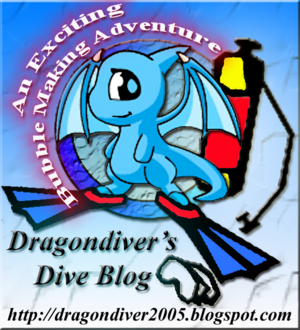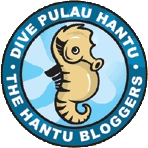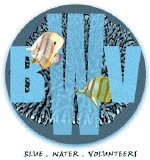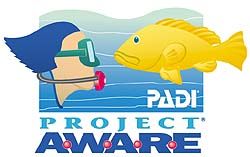Hantu Blog's 3rd Anniversary Dive Part THREE
25 March 2007
Dive No. 2 - Operation Rescue
Dive Site: Southern Jetty
Location: Pulau Hantu Besar
Visibilty: 3 m
Temperature: 29°C
Maximum Depth: 13.7 m
Actual Bottom Time: 53 mins
Time In: 1335 hrs
We headed out in different groups and this dive turned out to be more than just fruitful. In fact, it was meaningful for most of us who rendered the release of trapped animals. There were bubus around the shallows laid down by fishermen. Most were discarded but some were still functional as traps for marine creatures. Those of us, who happened to come across enmeshed fishes, tried our best to extricate them unharmed. We yielded successful outcome.
 I was surprised at first, when I noticed a Spanish Flag Snapper (Lutjanus carponotatus) laying perfectly motionless and head down in an unconventional position. Then I saw a hook in its jaw. I thought it was dead but as I approached, it put up a bit of futile struggle to break free from its painful entanglement. Before I set to release it, I checked the line... It was slacked. Debby came to my aid and together, we unhooked and disengaged the animal. It swam free... turning back again glancing at us as if with some sort of gratitude.
I was surprised at first, when I noticed a Spanish Flag Snapper (Lutjanus carponotatus) laying perfectly motionless and head down in an unconventional position. Then I saw a hook in its jaw. I thought it was dead but as I approached, it put up a bit of futile struggle to break free from its painful entanglement. Before I set to release it, I checked the line... It was slacked. Debby came to my aid and together, we unhooked and disengaged the animal. It swam free... turning back again glancing at us as if with some sort of gratitude.
Afterwards onboard the boat, Geraldine told us they've encountered a strange shark trapped in a bubu but was also released unharmed. Chayhoon, Gina and some others also set free trapped fishes along their dive path. It was collectively a conservation effort by all who have a heart for the marine lives of Singapore.

The strange epaulette shark turned out to be a White-spotted Bamboo Shark (Chiloscyllium plagiosum) which is listed on IUCN Red List of Threatened species. See info here
The above shark photo is copyrighted and taken by Geraldine
Here are the other fantastic encounters:
The crawling jewels of the sea...
 Another purplish-orange colour variant of the Bullock's Hypselodoris (Hypselodoris bullockii).
Another purplish-orange colour variant of the Bullock's Hypselodoris (Hypselodoris bullockii).
 My first sighting of The Emma's Hypselodoris (Hypselodoris emmae). Guess what? Take a closer look... It's laying its orange-red egg ribbon!!!
My first sighting of The Emma's Hypselodoris (Hypselodoris emmae). Guess what? Take a closer look... It's laying its orange-red egg ribbon!!!
Then it was the little stuffs on the sea whips...
Dive No. 2 - Operation Rescue
Dive Site: Southern Jetty
Location: Pulau Hantu Besar
Visibilty: 3 m
Temperature: 29°C
Maximum Depth: 13.7 m
Actual Bottom Time: 53 mins
Time In: 1335 hrs
We headed out in different groups and this dive turned out to be more than just fruitful. In fact, it was meaningful for most of us who rendered the release of trapped animals. There were bubus around the shallows laid down by fishermen. Most were discarded but some were still functional as traps for marine creatures. Those of us, who happened to come across enmeshed fishes, tried our best to extricate them unharmed. We yielded successful outcome.
 I was surprised at first, when I noticed a Spanish Flag Snapper (Lutjanus carponotatus) laying perfectly motionless and head down in an unconventional position. Then I saw a hook in its jaw. I thought it was dead but as I approached, it put up a bit of futile struggle to break free from its painful entanglement. Before I set to release it, I checked the line... It was slacked. Debby came to my aid and together, we unhooked and disengaged the animal. It swam free... turning back again glancing at us as if with some sort of gratitude.
I was surprised at first, when I noticed a Spanish Flag Snapper (Lutjanus carponotatus) laying perfectly motionless and head down in an unconventional position. Then I saw a hook in its jaw. I thought it was dead but as I approached, it put up a bit of futile struggle to break free from its painful entanglement. Before I set to release it, I checked the line... It was slacked. Debby came to my aid and together, we unhooked and disengaged the animal. It swam free... turning back again glancing at us as if with some sort of gratitude.Afterwards onboard the boat, Geraldine told us they've encountered a strange shark trapped in a bubu but was also released unharmed. Chayhoon, Gina and some others also set free trapped fishes along their dive path. It was collectively a conservation effort by all who have a heart for the marine lives of Singapore.

The strange epaulette shark turned out to be a White-spotted Bamboo Shark (Chiloscyllium plagiosum) which is listed on IUCN Red List of Threatened species. See info here
The above shark photo is copyrighted and taken by Geraldine
Here are the other fantastic encounters:
The crawling jewels of the sea...
 Another purplish-orange colour variant of the Bullock's Hypselodoris (Hypselodoris bullockii).
Another purplish-orange colour variant of the Bullock's Hypselodoris (Hypselodoris bullockii).Then it was the little stuffs on the sea whips...

Right: A White-lined Whip Goby (Bryaninops amplus) living on its sea whip host.
Other interesting finds....
 A Carpet Eel-Blenny (Congrogadus subducens) is also called a Wolf Eel but it is neither an Eel nor a Blenny. In fact it's a Dottyback. It has a long body that's shaped like an eel's and is capable of changing its colour. The fish is sexually dimorphic - the female is pinkish brown while the male is green.
A Carpet Eel-Blenny (Congrogadus subducens) is also called a Wolf Eel but it is neither an Eel nor a Blenny. In fact it's a Dottyback. It has a long body that's shaped like an eel's and is capable of changing its colour. The fish is sexually dimorphic - the female is pinkish brown while the male is green. A school of Yellow-tail Barracudas swam pass as Debby and I prepared to ascend.
A school of Yellow-tail Barracudas swam pass as Debby and I prepared to ascend.Labels: Dive Report




















































